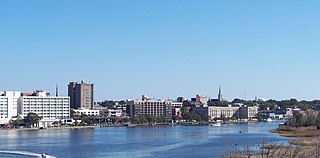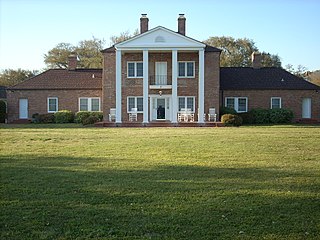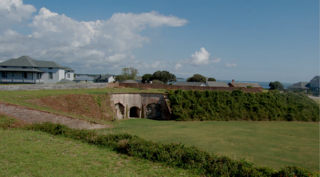
Brunswick County is a county located in the U.S. state of North Carolina. It is the southernmost county in the state. As of the 2020 census, the population was 136,693. Its population was only 73,143 in 2000, making it one of the fastest-growing counties in the state. With a nominal growth rate of approximately 47% in ten years, much of the growth is centered in the eastern section of the county in the suburbs of Wilmington such as Leland, Belville and Southport. The county seat is Bolivia, which at a population of around 150 people is among the least populous county seats in the state.

Southport is a city in Brunswick County, North Carolina, United States, near the mouth of the Cape Fear River. Its population was 3,971 as of the 2020 census. The current mayor, Rich Alt, was elected to a two-year term in November 2023.

Wilmington is a port city in New Hanover County, North Carolina, United States. With a population of 115,451 as of the 2020 census, it is the eighth-most populous city in the state. The county seat of New Hanover County, it is the principal city of the Wilmington metropolitan area, which includes New Hanover, Brunswick, and Pender counties. As of 2023, the region had an estimated population of 467,337.
Francis Nash was a brigadier general in the Continental Army during the American Revolutionary War. Prior to the war, he was a lawyer, public official, and politician in Hillsborough, North Carolina, and was heavily involved in opposing the Regulator movement, an uprising of settlers in the North Carolina piedmont between 1765 and 1771. Nash was also involved in North Carolina politics, representing Hillsborough on several occasions in the colonial North Carolina General Assembly.

Lieutenant-General William Tryon was a British Army officer and colonial administrator who served as governor of North Carolina from 1764 to 1771 and the governor of New York from 1771 to 1777. He also served during the Seven Years' War, the Regulator Movement, and the American War of Independence.

Robert Howe was a Continental Army general from the Province of North Carolina during the American Revolutionary War. The descendant of a prominent family in North Carolina, Howe was one of five generals, and the only major general, in the Continental Army from that state. He also played a role in the colonial and state governments of North Carolina, serving in the legislative bodies of both.

Pleasure Island is a coastal barrier island in Southeastern North Carolina, United States, just south of the City of Wilmington. Pleasure Island is located within Federal Point Township, in New Hanover County. The coastal resort towns of Carolina Beach and Kure Beach, as well as the annexed communities of Wilmington Beach and Hanby Beach are located on the island. The southern end of Pleasure Island was separated from Bald Head Island by Corncake Inlet until the inlet was shoaled and closed in 1998 by Hurricane Bonnie; thus Pleasure Island and Bald Head Island are no longer separate islands.
James Moore was an American military officer who served in the Continental Army during the American Revolutionary War. Moore was born into a prominent political family in the colonial Province of North Carolina, he was one of only five generals from North Carolina to serve in the Continental Army. He spent much of his childhood and youth on his family's estates in the lower Cape Fear River area, but soon became active in the colonial military structure in North Carolina.

Fort Anderson is a mid-19th-century earthen fort in the lower Cape Fear Region of North Carolina, located over the ruins of the colonial town of Brunswick in Brunswick County. It was built as a Confederate Fort by major general Samuel Gibbs French during the American Civil War. The fort was pivotal in protecting the Cape Fear River inlets and Wilmington upstream. Earthen batteries comprise the fort and were used as platforms and shields for the Confederate cannons. Beneath some of the earthworks were "bombproofs," shelters used by troops during enemy bombardment. The Confederacy decided to build forts around the Cape Fear River to protect the port of Wilmington from the Union blockade. During the Civil War, blockade runners brought supplies such as iron, guns, and ammunition to the Confederacy. The purpose of the fort was to hinder movement of Union ships, and to serve as a dropping off point for blockade runners fortunate enough to make it up the mouth of the Cape Fear River. Fort Anderson was built on the ruins of Brunswick Town and was originally named Fort St. Philip, after the ruins of the Revolutionary period church nearby. The name was changed to honor Col. George B. Anderson.

St. Philip's Church, Brunswick Town, is a ruined parish church in Brunswick County, North Carolina, United States. The Anglican church was erected in 1768 and destroyed in 1776. The ruins are located beside the Cape Fear River in the Brunswick Town Historic District, along with Fort Anderson, Russelborough, and the nearby Orton Plantation. During the American Revolutionary War, British forces attacked Brunswick Town in 1776 and burned the church. Before its demise, the church was considered one of the finest religious structures in North Carolina. On February 26, 1970, the historic site was added to the National Register of Historic Places.

Military Ocean Terminal Sunny Point (MOTSU) is one of the largest military terminals in the world. It serves as a transfer point between rail, trucks, and ships for the import and export of weapons, ammunition, explosives and military equipment for the United States Army and is operated by the 596th Transportation Brigade.

General Hugh Waddell was an Irish-born military officer, merchant, planter and politician who served in the Thirteen Colonies during the mid-18th century. Waddell formed and led a provincial militia unit in Rowan County, North Carolina and the Ohio River Valley during the French and Indian War and the Anglo-Cherokee War, and supervised the construction of Fort Dobbs near the settlement of the Fourth Creek Congregation. His career was well-served by close connections to several provincial governors of North Carolina.

1776 is celebrated in the United States as the official beginning of the nation, with the Declaration of Independence of the Thirteen Colonies from the British Empire issued on July 4.

Fort Johnston was a British fort, later a United States Army post, in Brunswick County, North Carolina on Moore Street near Southport, North Carolina. It stands on the west bank of the Cape Fear River, four miles above its mouth.

The Battle of Alamance, which took place on May 16, 1771, was the final confrontation of the Regulator Movement, a rebellion in colonial North Carolina over various issues with the Colonial Government. The Regulators primarily wanted reforms to the currency act and to stop local corruption. They will also request other changes, like secret ballot voting, progressive taxation, land reform, and more transparent government. Named for nearby Great Alamance Creek, the battle took place in what was then Orange County and has since become Alamance County in the central Piedmont area, about 6 miles (9.7 km) south of present-day Burlington, North Carolina.

Fort Dobbs was an 18th-century fort in the Yadkin–Pee Dee River Basin region of the Province of North Carolina, near what is now Statesville in Iredell County. Used for frontier defense during and after the French and Indian War, the fort was built to protect the American settlers of the western frontier of North Carolina, and served as a vital outpost for soldiers. Fort Dobbs' primary structure was a blockhouse with log walls, surrounded by a shallow ditch, and by 1759, a palisade. It was intended to provide protection from French-allied Native Americans such as the Shawnee raids into western North Carolina.
James Innes was an American military commander and political figure in the Province of North Carolina who led troops both at home and abroad in the service of the Kingdom of Great Britain. Innes was given command of a company of North Carolina's provincial soldiers during the War of Jenkins' Ear, and served as Commander-in-Chief of all colonial soldiers in the Ohio River Valley in 1754 during the French and Indian War. After resigning his commission in 1756, Innes retired to his home on the Cape Fear River. A bequest made by Innes upon his death led to the establishment of Innes Academy in Wilmington, North Carolina.

Located in North Carolina on the Atlantic Coast, the Fort Caswell Historic District encompasses 2 sites, 43 buildings, and 23 structures; it was added to the National Register of Historic Places in 2013. The fort itself was occupied by various branches of the U.S. armed forces for most of the period between 1836 and 1945 and is now a part of the North Carolina Baptist Assembly, a Christian retreat, owned and operated by the Baptist State Convention of North Carolina. It is accessible by the public to a limited extent per the conditions set forth by the Assembly’s Director.

The Brunswick Town raid was an attack on Brunswick Town, North Carolina, conducted by Spanish privateers between September 3 and 6, 1748, during the War of Jenkins' Ear. The raiders were eventually driven off, which resulted in the destruction of one of their vessels. It was the final engagement of the war and resulted in a British victory.
In the first half of 1776, the Thirteen Colonies individually declared independence from the British Empire. On July 4, the Declaration of Independence marked the beginning of the United States.




















